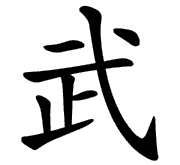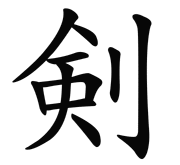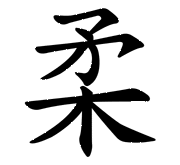
In Asia, since ancient times the spear has been the symbol of the warrior. Rendered into calligraphy in ideographic form, the spear is a basis for many kanji. It is the root for bu, the prefix used in a number of words concerned, not surprisingly, with things of a martial nature. There is bugei (martial skills), bushi (the feudal class of warrior gentility), and buke (an ancestral warrior family).
It would seem logical that the character for the spear alone would be sufficient to connote military. But, in making up the kanji for bu, the brushstrokes for spear are accompanied by additional strokes that mean “suppressing a revolt. ” The whole character for military, then, actually refers to “quelling an uprising by use of the polearm. “
Smothering insurrections has been the purview of the military throughout civilization. Nowhere more than in Japan has it been the task of the warrior caste to enforce order. In the best of times, these military efforts restored peace and promoted culture in Japan. In the worst, they reinforced cruel oppression and crushed the spirit of the land. And so the bushi, the only well-armed class of old Japan, were both heroes to the people as well as tools of tyrants.
The spear used in the Japanese martial arts, the yari, is not a projectile weapon. It was wielded on the battlefield like a polearm. The yari’s tip is pointed for thrusting, but the blade typically is long and edged on both sides. The yari could be used to slash either right or left. So it is apt that the yari, a weapon to cut in opposing directions, would form the basis of so many words dealing with the martial. Just as he may today, the warrior in feudal Japanese society could cut both ways: for good or for evil.

To test a sword crafted by the master smith Muramasa, its owner held the blade’s edge against the current in a stream. A leaf floated by; it touched the blade, and by the force of the current alone, it was sliced cleanly. The test was considered an ultimate trial of a sword’s quality-until someone thought to try it with a sword made by Muramasa’s master, the great Masamune. The Masamune sword was thrust into the stream, and another leaf swept toward it. Then, miraculously, the course of the leaf changed. It floated around the deadly edge, sailing on intact, as if the Masamune sword possessed a beneficent power beyond that for simply causing destruction.
The sword, or ken, along with the jewel and the mirror, is one of the three sacred treasures associated with Japan’s mythic creation. The crafting of the ken, too, is veiled in a ritual of mysticism. The swordsmith, even today, works at his forge attired in the white garments of the Shinto priest. Accompanied by apprentices wielding long-handled hammers, he chants and bangs a rhythm on the anvil, as a bar of molten iron glows and is then smashed into fiery sparks. Quenched, refined, the metal is flattened and folded again and again to make thousands of laminations. The process takes place before a Shinto altar and other consecrated trappings adorning the smithy, and it includes steps both religious and technical known only to the smith. The product is a weapon to inspire a kind of worshipful awe, as did Masamune’s blade. The ken exists in a dimension between the substantive and the fantastic.
The kanji for ken has a simple radical, two strokes representing the long blade of the sword, and another component that means “a combining.” A combining of what? Perhaps of the fire and prayer and pounding of steel that produce the sword. A combination of its edge, hard and keen as a diamond razor, and its spine, sturdy and flexible to absorb the shock of cutting. The “combining” in the kanji could refer to the sword’s incarnation as an object of beauty and as a brutal tool for cleaving a human neatly at any angle. Or could it be the combining of the reality and the legend that, like the test of the ken of Masamune and Muramasa, have long characterized the dual nature of the Japanese sword?

In springtimes long ago, the sages of China were given to celebrating the season by sipping rare teas, composing verse, and dining on fresh bamboo shoots. The emergence of takenoko, as young bamboo is called in Japanese, is a remarkable phenomenon throughout Asia in the spring. Pushing up with vigor, green sprouts of bamboo can pierce concrete if it lies between them and the sun. They grow with such force that they can actually be heard in the act: a rustling sound of renewal in the quiet spring night.
The energy of all young shoots in the plant world is extraordinary, especially so considering their delicacy. The slightest breeze can bend new growth. With nothing more than a bit of twine and bamboo poles as guides, the Japanese gardener can train the young boughs of a pine in fantastic shapes. Tender plant shoots can be trained, bent, and swayed, but so long as they are alive, they cannot be stopped. They are, for all their tenderness, indomitable.
The character for spear rests atop that for tree to create the kanji for ju. The etymological implication is that the growth of the tree has the power of a spear thrust. Ju–and this is the familiar prefix of judo and jujutsu–refers to the forces of pliancy. Ju is flexible strength, gentle potency. It is tenacity of a sort that embraces malleability. It bends to endure. Ju is durably soft; it receives in order to resist.
In a sense, ju is the process of turning to an aggressor the other cheek–only to use the movement of the turn to effect his defeat. The bugeisha who seeks to implement ju cannot settle for the brute stroke of the sledge. He needs the sensitive probe of the surgeon’s scalpel. Ju requires a connection to the opponent, physical at the beginner’s level, more mental at the expert’s, to palpate for strengths and weaknesses. Once discovered, ju can be applied to adapt to both these, the physical and the mental. To establish this connection in the dynamic action of conflict, the muscles and mind of the bugeisha flex and conform to ever-changing circumstances. Like the bamboo’s spring growth, the ju of the bugeisha is always yielding yet as unstoppable as the season itself.
Copyright ©1995 Dave Lowry. All rights reserved.
This article first appeared in Sword & Brush, Shambhala, 1995.
